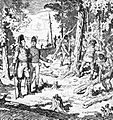Ontario Highway 11 facts for kids
Quick facts for kids
Highway 11 |
||||
|---|---|---|---|---|
| Lua error in Module:Infobox_road/map at line 15: attempt to index field 'wikibase' (a nil value). | ||||
| Route information | ||||
| Maintained by the Ministry of Transportation of Ontario | ||||
| Length | 1,784.9 km (1,109.1 mi) | |||
| Existed | 1920–present | |||
| Major junctions | ||||
| South end | ||||
| West end | ||||
| Location | ||||
| Major cities: | Barrie, Orillia, North Bay, Temiskaming Shores, Thunder Bay | |||
| Towns: | Gravenhurst, Bracebridge, Huntsville, Burk's Falls, South River, Powassan, Temagami, Englehart, Matheson, Cochrane, Kapuskasing, Hearst, Longlac, Geraldton, Nipigon, Fort Frances, Rainy River | |||
| Highway system | ||||
|
||||
Ontario Highway 11 is a very long road in Ontario, Canada. It's a special kind of road called a provincial highway, which means it's managed by the province. Highway 11 is about 1,780 kilometers (1,106 miles) long. This makes it the second longest highway in Ontario!
It starts in a city called Barrie in Central Ontario, where it connects with Highway 400. From there, it stretches all the way north and then west. It goes around the northern part of the Great Lakes. The highway finally ends near the border with Minnesota, in a town called Rainy River, Ontario.
Contents
What is a Highway?
A highway is a main road that connects different towns and cities. Highways are built to help people travel long distances quickly and safely. They are usually wider than local roads and have fewer stops. This allows cars and trucks to move smoothly.
Why are Highways Important?
Highways like Highway 11 are super important for many reasons. They help people visit friends and family in other cities. They also allow businesses to transport goods from one place to another. This means you can get fresh food and other products in your local stores. Highways also help tourists explore different parts of a region.
Journey Along Highway 11
Highway 11 takes you on an amazing journey through Ontario. It starts in the south and goes through many different types of landscapes. You'll see busy cities, quiet towns, and vast natural areas.
Southern Ontario to Cottage Country
The southern part of Highway 11 begins in Barrie. From there, it heads north towards Ontario's famous "Cottage Country." This area is known for its many lakes and forests. Towns like Orillia, Gravenhurst, Bracebridge, and Huntsville are popular spots for vacations. Many people travel on Highway 11 to reach their cottages or go camping.
Heading North: Forests and Lakes
As you continue north, Highway 11 passes through more wild and rugged areas. You'll go through places like North Bay and Temagami. This part of Ontario is famous for its beautiful forests, clear lakes, and wildlife. It's a great place for outdoor adventures like fishing, hiking, and canoeing.
Northern Ontario's Vastness
Further north, Highway 11 stretches across the huge region of Northern Ontario. It connects many smaller towns like Cochrane, Kapuskasing, and Hearst. This part of the highway is very long and can feel quite remote. It plays a key role in connecting these northern communities to the rest of the province.
Towards the Western Border
After heading north, Highway 11 turns west. It passes through cities like Thunder Bay, which is a major port city on Lake Superior. From Thunder Bay, the highway continues west, going through towns like Fort Frances and Rainy River. This final stretch brings you close to the border with the United States.
History of Highway 11
Highway 11 has a long and interesting history. Parts of it were once old trails and roads used by early settlers. Over time, these paths were improved and connected to form the highway we know today.
Early Beginnings
Some parts of Highway 11 were built on routes that were important even before cars existed. For example, parts of it follow the path of the old Yonge Street, which was a very early road in Ontario. Building these roads was hard work, often done by hand.
Connecting Communities
In the early 1900s, there was a big effort to build better roads across Ontario. Highway 11 was officially established in 1920. Its goal was to connect the growing towns and cities in the south with the resource-rich areas of Northern Ontario. This helped with trade and made it easier for people to move around the province.
Modern Improvements
Over the years, Highway 11 has been updated many times. Sections have been widened, new bridges have been built, and surfaces have been paved. These improvements make the highway safer and more efficient for everyone who uses it. Today, it remains a vital link for travel and business in Ontario.
Images for kids
-
John Graves Simcoe supervising the Queen's York Rangers cutting trees during the construction of Yonge Street, 1795
-
As a result of provincial downloading of highways to municipalities in 1996 and 1997, Highway 11 now begins at the "Crown Hill" interchange with Highway 400 north of Barrie. Previously it extended south to Lake Ontario in Toronto, mostly as Yonge Street
-
Highway 11 facing south from Highway 12 in Orillia












